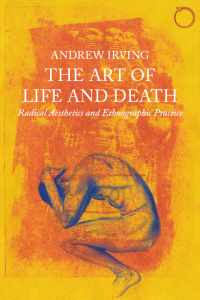Radical Aesthetics and Ethnographic Practice
By Andrew Irving
The Art of Life and Death explores how the world appears to people who have an acute perspective on it: those who are close to death. Based on extensive ethnographic research, Andrew Irving brings to life the lived experiences, imaginative lifeworlds, and existential concerns of persons confronting their own mortality and non-being.
Encompassing twenty years of working alongside persons living with HIV/AIDS in New York, Irving documents the radical but often unspoken and unvoiced transformations in perception, knowledge, and understanding that people experience in the face of death. By bringing an “experience-near” ethnographic focus to the streams of inner dialogue, imagination, and aesthetic expression that are central to the experience of illness and everyday life, this monograph offers a theoretical, ethnographic, and methodological contribution to the anthropology of time, finitude, and the human condition. With relevance well-beyond the disciplinary boundaries of anthropology, this book ultimately highlights the challenge of capturing the inner experience of human suffering and hope that affect us all—of the trauma of the threat of death and the surprise of continued life.
The art of life and death is unlike anything I have ever read in its combination of theoretical ambition and methodological innovation. The book is the fruit of Irving’s close collaboration with a remarkable group of men and women diagnosed with AIDS at a time when there was little hope of surviving the disease. With the help of their words and, crucially, their art, Irving illuminates the “complex inner life world” created by the trauma of threatened death and the surprise of continued life. Inner experience, and the challenge of capturing it, lie at the heart of this book.
— Danilyn Rutherford, author of Laughing at Leviathan
The art of life and death is a monumental anthropological achievement. Fusing long-term fieldwork, deeply sensitive observation and a refined sense the phenomenology of our deep existential fears—of illness, of death, and the emotional quandaries of having survived a confrontation with mortality, Andrew Irving demonstrates how imaginative ethnography can reveal to us the deep contours of human being. The art of life and death is filled with gripping narratives not only of pain, confusion, but also of courage and resilience. It is a theoretically informed text that will long remain open to the world.
— Paul Stoller, author of Yaya’s story
The art of life and death is a brilliantly engaging piece of work that invites us to rethink life itself and introduces new ways of carrying out anthropological research. Through a compelling interweaving of ethnography and theory, Irving takes us close to lives that have been lived under conditions of existential uncertainty and recovery. This book goes beyond conventional anthropology to offer a thoroughly inspiring account from which we learn not only about what it means to live near death but how art and the senses are implicated in life. It will endure as an outstanding example of how do anthropology at its best.
— Sarah Pink, coauthor of Uncertainty and possibility
In this imaginatively conceived book Andrew Irving asks compelling and daring questions on how to think of such categories as “experience,” “inner life,” or “subjectivity” in the face of imminent death. He follows up with a very careful and caring ethnography of how art and life flow into each other. Irving achieves perfect pitch in his writing. A splendid achievement.
— Veena Das, author of Affliction
2017
264 pages
ISBN: 9780997367515
Price: $35.00
Download PDF
Table of Contents
Reviews
Choice Reviews 55, no. 11:
This beautifully written and constructed book weaves together sophisticated social theory, philosophy, art work, and vivid biographical narratives to offer insights into how HIV/AIDS patients have learned to “live a meaningful existence in the pre- and post-antiretroviral eras while negotiating a terminal illness.” Basing his book on 20 years of work with adults living with HIV/AIDS in New York, visual anthropologist Irving (Univ. of Manchester) has carried out a compelling anthropological study of the “complex inner world” of those who struggle, cope, fight, and ultimately come to terms with their own impending deaths. The author draws on philosophical writings and social theories to contextualize his results, but is at his best when allowing his subjects to speak for themselves. The evocative words of subjects like artist Albert Velasco provide fascinating insights into the ways that dying persons with HIV/AIDS grapple with the mundane, like keeping medical appointments, as well as the profound reckoning with their own mortality and purpose. An engaging read that will enrich upper-level and graduate collections on death and dying, ethnographic methods, and HIV/AIDS.
